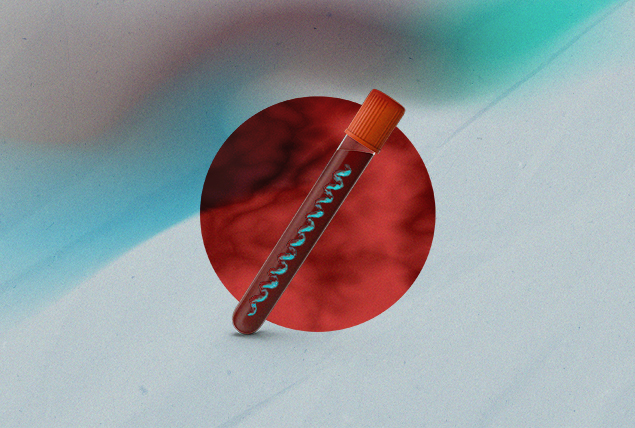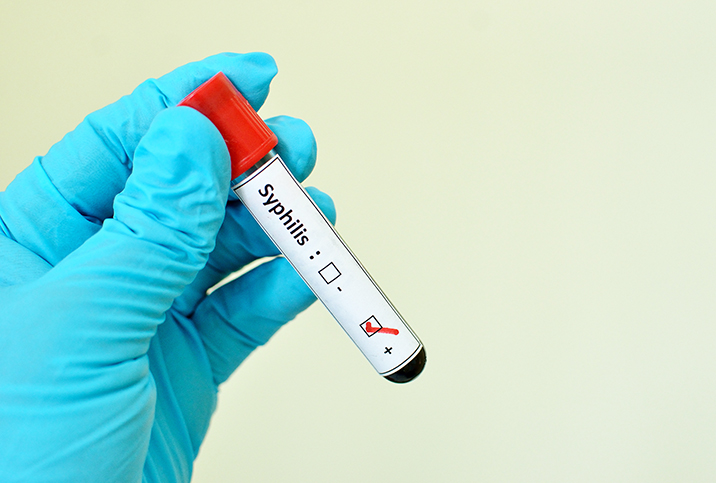The Symptoms of Syphilis: They're All too Easy to Overlook

Syphilis is one of the oldest sexually transmitted diseases (STDs), with records revealing its existence dates back to medieval 15th-century Europe. Of course, back then we didn't have antibiotics, which meant a diagnosis of syphilis caused sufferers to look forward to a slow and miserable journey toward the grave.
Nowadays, syphilis can be easily treated and cured long before it causes irreversible damage. Barbara Bawer, M.D., a family medicine physician at Ohio State University Wexner Medical Center, said there are four stages of syphilis
- Primary
- Secondary
- Latent
- Tertiary
In general, syphilis almost never advances past the secondary stage in developed countries because its symptoms—rash, swollen lymph nodes, fever and so on—usually are obvious enough to encourage people to seek treatment.
"The populations most affected have varied through the centuries, and in the United States since 2001, the population most affected have been men who have sex with other men, typically if [they have] more than one partner," said Dana Dunne, M.D., M.H.S., an associate professor of medicine (infectious diseases) at Yale School of Medicine in New Haven, Connecticut, and the founding and core faculty member for the Yale Primary Care HIV Training Track. "Over the past five years, however, there have been cases rising among women as well and a corresponding increase in babies being born with congenital syphilis."
"Patients who are sexually active are at risk for syphilis," said Ashley Jennings, M.D., a board-certified OB-GYN and a clinical associate professor at the University of Wisconsin School of Medicine and Public Health in Madison. "The number of cases is on the rise in the U.S. and the majority of cases—80 percent—are diagnosed in men."
In fact, syphilis affects 20 million people worldwide, said Adi Katz, M.D., the director of gynecology and director for the obstetrics and gynecology residency program at Lenox Hill Hospital in New York City.
"In the United States, it has been a reportable disease since 1944 through a unique laboratory testing process," she added. "In the U.S. in 2020, 133,945 cases of syphilis—all stages—were reported, which was up 52 percent from 2016. The incidence has been increasing since 2010, and approximately 80 percent of primary and secondary syphilis cases occur in men."
Causes and how it spreads
"Syphilis is caused by a bacterium named Treponema pallidum," Dunne said. "It is a spiral-shaped bacteria like the one that causes Lyme disease. Humans are the only hosts for the bacteria, so it can't be contracted through foods or insect bites, etcetera."
The primary method of spread for syphilis is through sexual contact, typically anal, oral and vaginal. Depending on the stage, a person with syphilis can be asymptomatic, thus, unknowingly spreading the disease to new partners. On a more optimistic note, the syphilis bacteria can't survive outside their host, which means it can be transmitted only through direct contact with an infected human, rather than direct contact with random objects.
Even though syphilis is commonly acquired through exposure to an infected person's bodily fluids during anal, oral or vaginal sex, it's possible to acquire the bacteria through deep kissing, a blood transfusion—although blood donations in the U.S. are screened for syphilis—or an infected needle.
Transmission can occur by direct skin contact with an open lesion or chancre, a sore that commonly appears during the early (primary) stage of syphilis.
Known for its raised, circular borders, a chancre is highly infectious and typically appears within three to four weeks on average after first contact with an infected person. In some cases, multiple sores may appear, typically on the genitals, anus, mouth or lips. However, a chancre can appear on any part of the skin where contact with the syphilis-causing bacteria was made.
Syphilitic chancres occur during the primary stage of syphilis, the first stage of the infection. They are usually painless and may go unnoticed, depending on where they appear on the body. If it shows up in an area that is not easily visible, such as the anus or vagina, then a person may not be aware they have primary-stage syphilis.
Transmission of the disease can happen at this stage if the person with syphilis isn't paying attention to their body or the body of a sexual partner.
Syphilitic chancres eventually heal on their own, but if the underlying disease is left untreated, it progresses to the second stage, which occurs about two to eight weeks after the initial infection.
At this point, the bacteria have invaded the bloodstream, causing a different set of symptoms to emerge, including rashes, fever and swollen lymph nodes. This is the time for detection and treatment to be a high priority because once syphilis progresses past the second stage and into the latent or tertiary stages, it can be fatal or lead to irreversible damage to the body.
Men are the most vulnerable group. According to research published in 2021, the prevalence of syphilis has increased over the past decade in the U.S. Among all people with syphilis, an estimated 70 percent are biological men and 80 percent of new incidences also involve men. Other large-scale studies, including one published in the Lancet in 2021, have described the syphilis prevalence in men who have sex with men as "unacceptably high."
According to a 2020 study conducted on gay men infected with syphilis, those who mainly practice receptive anal intercourse are more likely to have secondary-stage syphilis when compared with men who primarily practice insertive anal sex.
These findings indicate men who penetrate during anal sex tend to detect syphilis early on, compared with men who get penetrated. This is supported by the finding that 92 percent of patients who practice insertive anal sex had chancres appear on the surface of the penis, while 73 percent of those who practice receptive anal sex had anal chancres. Essentially, insertive anal sex will likely lead to a visible chancre on the penis, while receptive anal sex will likely lead to chancres in the anus or rectum.
Since the latter may go unnoticed especially when chancres are painless the disease may not be obvious until it progresses to the secondary stage. On the other hand, people who notice chancres on their penis may seek treatment early while the disease is still in the primary stage.
Either way, it's important to practice safer sex to best mitigate the risk of contracting syphilis.
Babies can get syphilis, too
Sexual contact isn't the only way syphilis is transmitted from one person to another.
Congenital syphilis can occur when a pregnant woman has untreated syphilis and passes the disease on to her unborn child. Unfortunately, this type of syphilis is on the rise.
According to the Centers for Disease Control and Prevention (CDC), 1,870 cases were reported in 2019, and approximately 7 percent of the babies were either stillbirths or died during infancy. Mother-to-child transmission is much more prevalent in less developed countries, according to research published in 2016. Additionally, research from 2020 indicated about 70 percent of congenital syphilis births came from Black and Hispanic parents in the U.S.
While syphilis is a curable condition that's treated using penicillin, left untreated the disease increases a person's chances of acquiring human immunodeficiency virus (HIV). In fact, research published in 2020 indicated the risk of acquiring HIV was twice as high among people who had been exposed to syphilis when compared with a control group.
No longer a death sentence
It is important to understand a diagnosis of syphilis does not represent what it once did. Alexander Fleming's discovery of penicillin in 1928 was found to be a cure for syphilis. It's important to detect the symptoms and speak to your healthcare provider as soon as possible. Making a definitive diagnosis and receiving treatment as early as possible is important, and becomes more urgent as the disease progresses through its various stages.
However, not everyone with syphilis goes through every stage.
"You often see the symptoms of syphilis talked about in stages, even though not everyone will go through every stage," said Amanda Thornton, M.D., an infectious disease physician for Kaiser Permanente in Northern California. "After exposure, the earliest sign of infection is sores, which may not be noticed because they are often, but not always, painless. These sores may entirely go away without any treatment. If syphilis is not treated after initial sores, the next symptom may be developing a reddish-brownish, spotty rash on the body, which extends to the palms of your hands or feet."
Other symptoms include muscle aches, fever, sore throat and fatigue, among others, Thornton said.
"Sometimes it can spread to your nervous system, your eyes and internal organs, including your brain, and cause permanent damage. This can happen early on or years, even decades, later," Thornton said.
There are so many different presentations of syphilis that Thornton said it is known as "the great mimicker" because it can be confused with other illnesses depending on what sign of infection is first noticed. Be sure to keep your eyes open for any signs, and if you fear you have syphilis, contact your doctor so you can be treated promptly.


















